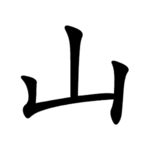| 山 | ||
|---|---|---|
| ||
| 山 (U+5C71) "mountain" | ||
| Pronunciations | ||
| Pinyin: | shān | |
| Bopomofo: | ㄕㄢ | |
| Gwoyeu Romatzyh: | shan | |
| Wade–Giles: | shan1 | |
| Cantonese Yale: | sāan | |
| Jyutping: | saan1 | |
| Pe̍h-ōe-jī: | san | |
| Japanese Kana: | サン san (on'yomi) やま yama (kun'yomi) | |
| Sino-Korean: | 산 san | |
| Names | ||
| Chinese name(s): | (Left) 山字旁 shānzìpáng (Top) 山字頭/山字头 shānzìtóu (Bottom) 山字底 shānzìdǐ | |
| Japanese name(s): | 山/やま yama (Left) 山偏/やまへん yamahen (Top) 山冠/やまかんむり yamakanmuri | |
| Hangul: | 메 me | |
| Stroke order animation | ||
 | ||
Radical 46 or radical mountain (山部) meaning "mountain" is one of the 31 Kangxi radicals (214 radicals total) composed of three strokes. It is found in the names of mountains generally in east Asia.
In the Kangxi Dictionary, there are 636 characters (out of 49,030) to be found under this radical.
山 is also the 39th indexing component in the Table of Indexing Chinese Character Components predominantly adopted by Simplified Chinese dictionaries published in mainland China.
In Taoist cosmology, 山 (mountain) is the nature component of the bagua diagram 艮 gèn. This diagram corresponds to the I Ching trigram ☶.